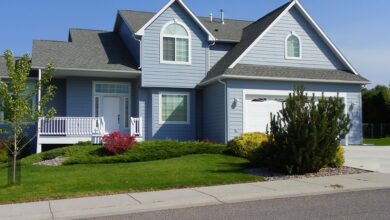commercial real estate value based on rental income: 7 Powerful Insights
Ever wondered how investors determine the true worth of a shopping mall, office tower, or warehouse? It’s not just about square footage—it’s about the cash flow. Discover how commercial real estate value based on rental income drives smart investment decisions.
Understanding Commercial Real Estate Value Based on Rental Income

When it comes to valuing commercial real estate, one of the most reliable and widely used methods is analyzing rental income. Unlike residential properties, where comparable sales often dominate valuation, commercial properties are primarily assessed based on their ability to generate consistent, predictable income. This approach, known as the income capitalization approach, treats real estate like a business: if it earns money, it has value.
What Is the Income Capitalization Approach?
The income capitalization approach, or “cap rate method,” estimates a property’s value by dividing its Net Operating Income (NOI) by a capitalization rate. This method is rooted in the principle that the value of an income-producing asset should reflect the income it generates over time. It’s a forward-looking model, making it ideal for investors focused on long-term returns.
- NOI = Gross Rental Income – Operating Expenses (excluding mortgage payments)
- Cap Rate = NOI / Current Market Value
- Value = NOI / Cap Rate
This formula allows investors to compare properties across different markets and asset classes on an apples-to-apples basis. For example, a property with an NOI of $100,000 and a cap rate of 5% would be valued at $2 million. If the same property were in a riskier market with a 7% cap rate, its value would drop to approximately $1.43 million—demonstrating how market perception and risk influence commercial real estate value based on rental income.
“The value of a commercial property is not in its bricks and mortar, but in the stream of income it produces.” — Real Estate Investment Principle
Why Rental Income Matters More Than Location Alone
While location is undeniably important, a prime location doesn’t guarantee profitability. A retail space on Fifth Avenue could sit vacant for months, generating zero income and thus zero value under the income approach. Conversely, a warehouse in a secondary market with long-term leases and reliable tenants can deliver steady returns. This is why savvy investors prioritize lease quality, tenant creditworthiness, and lease duration over mere geography when assessing commercial real estate value based on rental income.
commercial real estate value based on rental income – Commercial real estate value based on rental income menjadi aspek penting yang dibahas di sini.
For instance, a single-tenant net lease property occupied by a Fortune 500 company on a 15-year contract is often valued more favorably than a multi-tenant building with high turnover, even if the latter is in a more prestigious area. The predictability and security of income streams are paramount.
Key Factors Influencing Commercial Real Estate Value Based on Rental Income
Valuing commercial real estate isn’t a one-size-fits-all process. Multiple variables interact to shape how rental income translates into market value. Understanding these factors helps investors make informed decisions and avoid overpaying for underperforming assets.
Net Operating Income (NOI): The Foundation of Value
NOI is the cornerstone of income-based valuation. It represents the annual income generated by a property after deducting all operating expenses—such as property management fees, maintenance, insurance, and property taxes—but before mortgage payments and income taxes. A higher NOI directly increases the property’s value, assuming the cap rate remains constant.
For example, if two identical office buildings generate $200,000 and $250,000 in NOI respectively, and both are valued at a 6% cap rate, their values would be $3.33 million and $4.17 million. That $50,000 difference in NOI results in an $840,000 difference in value—highlighting the power of operational efficiency and rent optimization.
- NOI can be increased by raising rents, reducing vacancies, or cutting operating costs.
- Overestimating NOI due to optimistic occupancy assumptions is a common valuation pitfall.
- Accurate expense tracking is essential for reliable NOI calculation.
Investors should always verify historical NOI with actual rent rolls and expense statements rather than relying on seller-provided pro formas. Third-party audits or property management reviews can uncover discrepancies that significantly impact commercial real estate value based on rental income.
commercial real estate value based on rental income – Commercial real estate value based on rental income menjadi aspek penting yang dibahas di sini.
Capitalization Rate (Cap Rate): The Market’s Risk Meter
The cap rate reflects the rate of return an investor would expect if they purchased a property for all cash. It’s inversely related to value: higher cap rates mean lower prices (higher risk), while lower cap rates indicate higher prices (lower risk). Cap rates vary by property type, location, and market conditions.
- Class A office buildings in major cities: 4–5% cap rate
- Industrial warehouses in suburban areas: 6–7% cap rate
- Retail strip centers in secondary markets: 7–8% cap rate
For example, a cap rate expansion (increase) from 5% to 6% due to rising interest rates or economic uncertainty can reduce a property’s value by nearly 17%, even if NOI remains unchanged. This sensitivity makes cap rate analysis critical when evaluating commercial real estate value based on rental income.
According to the National Council of Real Estate Investment Fiduciaries (NCREIF), average cap rates for commercial properties have fluctuated between 4.5% and 7% over the past decade, reflecting shifts in investor sentiment and capital availability.
Lease Structure and Tenant Quality
Not all rental income is created equal. The structure of leases—gross, net, or modified gross—and the financial strength of tenants play a crucial role in determining value. Triple-net (NNN) leases, where tenants pay property taxes, insurance, and maintenance, transfer operational risk to the tenant, making them highly desirable.
A property leased to a national pharmacy chain under a 20-year NNN lease is typically valued at a lower cap rate (higher price) than a similar building with short-term leases to small local businesses. This is because the former offers predictable, low-maintenance income with minimal landlord responsibility.
commercial real estate value based on rental income – Commercial real estate value based on rental income menjadi aspek penting yang dibahas di sini.
- Investment-grade tenants (e.g., Walmart, FedEx, Starbucks) command premium valuations.
- Lease rollover risk: Properties with many leases expiring in the near term face income uncertainty.
- Percentage rent clauses in retail leases can boost income but add complexity to valuation.
For deeper insights into lease types and their impact, the International Council of Shopping Centers (ICSC) provides comprehensive resources on retail lease structures.
How to Calculate Commercial Real Estate Value Based on Rental Income
Calculating value using rental income involves a systematic process that combines financial analysis with market research. While the basic formula is simple, accurate valuation requires attention to detail and realistic assumptions.
Step 1: Gather Accurate Financial Data
The first step is collecting reliable data on the property’s income and expenses. This includes:
- Rent roll: A detailed list of all tenants, lease terms, rental rates, and expiration dates.
- Operating expenses: Historical records of property taxes, insurance, utilities, maintenance, and management fees.
- Vacancy and credit loss: Historical vacancy rates and any unpaid rent.
Publicly traded REITs (Real Estate Investment Trusts) often disclose detailed property-level financials, which can serve as benchmarks. For private properties, buyers should request at least two years of financial statements and verify them through third-party sources.
Tools like CoStar provide verified commercial property data, including rental rates and occupancy trends, helping investors validate income claims.
commercial real estate value based on rental income – Commercial real estate value based on rental income menjadi aspek penting yang dibahas di sini.
Step 2: Calculate Net Operating Income (NOI)
Once data is collected, calculate the property’s stabilized NOI. This means adjusting for temporary vacancies, one-time expenses, or below-market rents that may not reflect long-term performance.
For example, if a building has a 10% vacancy rate this year but historically averages 5%, the stabilized NOI should assume 95% occupancy. Similarly, if a tenant is paying $20/sq ft while market rates are $25/sq ft, the potential rent increase should be factored into future income projections.
Stabilized NOI = Potential Gross Income – (Vacancy Allowance + Operating Expenses)
This forward-looking approach ensures that the commercial real estate value based on rental income reflects realistic, sustainable earnings rather than short-term anomalies.
Step 3: Determine the Appropriate Cap Rate
Selecting the right cap rate is both an art and a science. It requires comparing the subject property to recent sales of similar assets in the same market. Factors to consider include:
- Property type (office, retail, industrial, multifamily)
- Location (primary, secondary, or tertiary market)
- Building class (A, B, or C)
- Tenant mix and lease terms
- Market supply and demand dynamics
For instance, a Class B office building in Austin, Texas, might trade at a 5.5% cap rate, while a similar building in Cleveland might command only a 6.8% cap rate due to lower growth expectations. Real capital markets platforms like Crexi and LoopNet publish recent transaction data that can help investors benchmark cap rates.
commercial real estate value based on rental income – Commercial real estate value based on rental income menjadi aspek penting yang dibahas di sini.
Once the cap rate is established, the valuation is straightforward: divide the stabilized NOI by the cap rate. A property with $300,000 in NOI and a 6% cap rate is worth $5 million.
Advanced Valuation Methods: Beyond the Cap Rate
While the cap rate method is widely used, it assumes stable, perpetual income. In reality, rental income fluctuates over time due to lease expirations, market cycles, and inflation. Advanced investors use more sophisticated models to capture these dynamics.
Discounted Cash Flow (DCF) Analysis
DCF analysis projects a property’s cash flows over a specific holding period (typically 5–10 years) and discounts them back to present value using a required rate of return (discount rate). This method accounts for:
- Varying rental income over time
- Lease renewals and rent escalations
- Capital expenditures (e.g., roof replacement)
- Resale value (reversion) at the end of the holding period
For example, an investor might project that a property will generate $200,000 in NOI in year one, grow at 3% annually, require a $100,000 roof replacement in year five, and be sold in year ten at a 6.5% cap rate. By discounting these cash flows at 8%, the investor arrives at a net present value that reflects the true economic worth of the asset.
DCF is especially useful for properties undergoing lease-up, redevelopment, or market transitions, where income is not yet stabilized. It provides a more nuanced view of commercial real estate value based on rental income than the static cap rate model.
commercial real estate value based on rental income – Commercial real estate value based on rental income menjadi aspek penting yang dibahas di sini.
Sensitivity Analysis and Scenario Planning
Because real estate markets are unpredictable, smart investors test their assumptions under different scenarios. Sensitivity analysis examines how changes in key variables—such as vacancy rates, rent growth, or cap rates—affect property value.
- Base case: 5% vacancy, 3% annual rent growth, 6% exit cap rate
- Bear case: 10% vacancy, 1% rent growth, 7% exit cap rate
- Bull case: 2% vacancy, 5% rent growth, 5% exit cap rate
This approach helps investors understand downside risks and upside potential. A property that loses 20% of its value in a bear case may be too risky for conservative investors, even if the base case looks attractive.
Software tools like ARGUS Enterprise are industry standards for DCF and sensitivity modeling in commercial real estate.
The Impact of Market Conditions on Commercial Real Estate Value Based on Rental Income
Even the most accurate financial models can’t escape the influence of broader economic forces. Interest rates, inflation, employment trends, and supply-demand imbalances all shape how rental income translates into property value.
Interest Rates and Capital Availability
When interest rates rise, the cost of borrowing increases, reducing investor demand for income-producing assets. This often leads to cap rate expansion—investors demand higher returns to compensate for increased financing costs and opportunity cost (e.g., competing with bond yields).
commercial real estate value based on rental income – Commercial real estate value based on rental income menjadi aspek penting yang dibahas di sini.
For example, during the Federal Reserve’s rate hikes in 2022–2023, cap rates for commercial properties rose by 50–100 basis points, leading to price declines of 10–20% in some sectors, despite stable NOI. This demonstrates how external financial conditions can decouple property value from rental income in the short term.
- Higher interest rates reduce leveraged returns, making all-cash buyers more competitive.
- Debt service coverage ratios (DSCR) tighten, limiting loan amounts.
- Refinancing risk increases for properties with maturing loans.
Investors must monitor the Federal Reserve’s monetary policy and its impact on commercial mortgage-backed securities (CMBS) spreads, which directly affect financing availability.
Supply and Demand Dynamics
Local market fundamentals are critical. A surge in new office construction can flood the market, increasing vacancy and putting downward pressure on rents. Conversely, limited industrial space in a logistics hub can drive rent growth and support higher valuations.
For instance, the e-commerce boom has dramatically increased demand for last-mile distribution centers, pushing industrial cap rates to historic lows (below 4% in some markets). This has significantly boosted commercial real estate value based on rental income for warehouse owners.
Meanwhile, the shift to remote work has reduced demand for traditional office space, leading to rising vacancies and rent concessions. As a result, office property values have declined even when current rental income remains stable—investors are pricing in future income risk.
commercial real estate value based on rental income – Commercial real estate value based on rental income menjadi aspek penting yang dibahas di sini.
Inflation and Rent Escalation Clauses
Inflation can be both a risk and an opportunity. While rising costs increase operating expenses, leases with built-in rent escalations (e.g., 2% annual increases or CPI-linked adjustments) can protect income streams.
Properties with strong inflation protection are more valuable because they preserve purchasing power over time. For example, a retail lease with a 3% annual rent bump will see income grow from $100,000 to $134,000 over 10 years, significantly increasing the property’s long-term NOI and value.
However, properties with long-term fixed rents may lose real income value during high inflation, making them less attractive to investors.
Risks and Limitations of Valuing Commercial Real Estate Based on Rental Income
While the income-based approach is powerful, it’s not without flaws. Overreliance on rental income projections can lead to overvaluation, especially in volatile markets.
Overestimating Future Income
One of the biggest risks is assuming that current occupancy and rental rates will continue indefinitely. Economic downturns, tenant bankruptcies, or industry disruptions (e.g., retail e-commerce) can quickly erode income.
commercial real estate value based on rental income – Commercial real estate value based on rental income menjadi aspek penting yang dibahas di sini.
For example, a shopping mall with 95% occupancy in 2019 may have dropped to 70% by 2022 due to store closures. Investors who valued the property based on pre-pandemic NOI suffered significant losses. This highlights the need for conservative, stress-tested assumptions when calculating commercial real estate value based on rental income.
Ignoring Physical and Environmental Risks
The income approach often overlooks physical deterioration or environmental liabilities. A building with structural issues or asbestos may generate strong rental income today but face massive future repair costs that erode NOI.
Environmental site assessments (Phase I ESA) and property condition assessments (PCA) are essential due diligence steps to uncover hidden risks that aren’t reflected in financial statements.
Market Liquidity and Exit Strategy
Even if a property is correctly valued, selling it at that price depends on market liquidity. In downturns, there may be few buyers, forcing sellers to accept lower prices regardless of income fundamentals.
Additionally, value is only realized upon sale or refinancing. An investor who overpays based on optimistic income projections may be “house poor” in real estate—cash flow positive but unable to exit at a profit.
commercial real estate value based on rental income – Commercial real estate value based on rental income menjadi aspek penting yang dibahas di sini.
Strategies to Maximize Commercial Real Estate Value Based on Rental Income
Smart investors don’t just passively accept a property’s current income—they actively enhance it. Value-add strategies can significantly increase NOI and, by extension, market value.
Lease Optimization and Tenant Curation
Upgrading tenants to stronger, longer-term occupants can reduce risk and increase rent. For example, replacing a local restaurant with a national bank chain on a 10-year NNN lease improves income stability and lowers cap rate.
- Renegotiate below-market leases at expiration.
- Offer tenant improvements to secure long-term commitments.
- Diversify tenant mix to reduce concentration risk.
Platforms like Yardi offer lease management tools that help track lease expirations and optimize renewal strategies.
Operational Efficiency and Cost Control
Reducing operating expenses directly increases NOI. Simple measures like energy-efficient lighting, preventive maintenance, and competitive vendor bidding can yield significant savings.
For instance, a 10% reduction in operating expenses on a property with $500,000 in NOI adds $50,000 to the bottom line. At a 6% cap rate, that’s an extra $833,000 in value—without raising a single dollar in rent.
commercial real estate value based on rental income – Commercial real estate value based on rental income menjadi aspek penting yang dibahas di sini.
Strategic Capital Improvements
Targeted renovations—such as updating HVAC systems, improving curb appeal, or adding amenities—can justify higher rents and attract premium tenants.
A 2023 study by the Urban Land Institute (ULI) found that properties with modernized lobbies and fitness centers commanded 15–20% higher rents in urban markets. These improvements often pay for themselves within a few years through increased NOI.
How is commercial real estate value based on rental income calculated?
It is primarily calculated using the income capitalization approach: Value = Net Operating Income (NOI) / Capitalization Rate. NOI is derived from annual rental income minus operating expenses, while the cap rate reflects market return expectations.
What is a good cap rate for commercial real estate?
commercial real estate value based on rental income – Commercial real estate value based on rental income menjadi aspek penting yang dibahas di sini.
A “good” cap rate depends on property type and location. Generally, 4–6% is typical for low-risk, prime assets in major markets, while 7–10% may indicate higher risk or opportunity in secondary markets.
Can a property have high rental income but low value?
Yes. If rental income is unstable, tied to weak tenants, or offset by high expenses or market risks, the property may still have low value. Short-term income doesn’t guarantee long-term value.
How do interest rates affect commercial real estate valuation?
Rising interest rates increase borrowing costs and investor required returns, leading to cap rate expansion and lower property values—even if rental income remains unchanged.
commercial real estate value based on rental income – Commercial real estate value based on rental income menjadi aspek penting yang dibahas di sini.
What is the difference between NOI and cash flow?
NOI excludes mortgage payments and taxes, focusing on property-level profitability. Cash flow includes debt service and is net to the investor, making it a measure of personal return rather than asset value.
Understanding commercial real estate value based on rental income is essential for any serious investor. By focusing on net operating income, cap rates, tenant quality, and market dynamics, investors can make informed decisions that balance risk and return. While the income approach is powerful, it must be applied with caution, using realistic assumptions and thorough due diligence. Ultimately, the true value of a commercial property lies not in its physical form, but in its ability to generate sustainable, growing income over time.
Further Reading:







